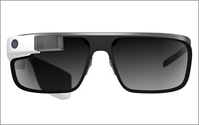 In
the emerging world of wearable technology, Ralph Lauren grabbed the spotlight this week with the debut of a new fitness-tracking shirt in connection with this year’s U.S. Open. The Polo Tech smart shirt, which tracks things like
breathing and heart rate, more aptly fits the “high tech meets high fashion” description than many other wearable gadgets rolled out to date. Someone might actually wear it even if the
technology didn’t work.
In
the emerging world of wearable technology, Ralph Lauren grabbed the spotlight this week with the debut of a new fitness-tracking shirt in connection with this year’s U.S. Open. The Polo Tech smart shirt, which tracks things like
breathing and heart rate, more aptly fits the “high tech meets high fashion” description than many other wearable gadgets rolled out to date. Someone might actually wear it even if the
technology didn’t work.
The same couldn’t be said for Google Glass, the smart eyewear Google soft-launched in 2012 with a small group of “Explorers,” but only made
available to the public widely this spring. In the interim, Glass has become the butt of widespread jokes and satirical gags like
this for its ungainly appearance and creepy connotation of constant surveillance.
It also gave rise to a new term, “Glassholes,” to describe its users.
Despite the
scorn heaped on it, Glass remains something of a flagship device for the wearables category, underscoring both the potential and peril of combining connectedness with clothing or other personal items.
And given that Glass will never be considered appearance-enhancing, that makes it all the more important that it actually works well.
On that score, as well, a new Consumer Reports review suggests Google still has a ways to go.
Based on its own testing, the publication made a $200 smartphone sound a lot better than a new, $1,500 Google headset for taking photos, shooting video, sound quality and battery life. “Pictures
shot in bright light were slightly oversaturated, images were noisy, and contrasts lacked depth and dimension,” stated the review. Ditto for video.
The magazine also pointed out that
Google’s claim of one-day’s battery life for Glass for “typical use,” turned out to be only about three hours under what its lab testers considered “moderate” and
“heavy use.” That includes things like following turn-by-turn directions, recording video and listening to music.
So simply on a practical level, it appears Glass isn’t about
to go mainstream, especially at its current price. But the Consumer Reports acknowledges wearable tech is still in its early days, with more improvements to come. Glass, for example, already looks
less clunky as headgear than when first introduced.
“As computing power migrates into our clothing, jewelry, and, yes, our eyeglasses, engineers are certain to come up with
lighter-weight, more convenient mobile technologies for delivering text messages, serving up timely data, and possibly targeting us with location-specific ads,” it states. That last option, of
course, is one that may fulfill marketers’ hopes for the category. But it could also wind up being another reason people won’t warm to wearable devices in large numbers.